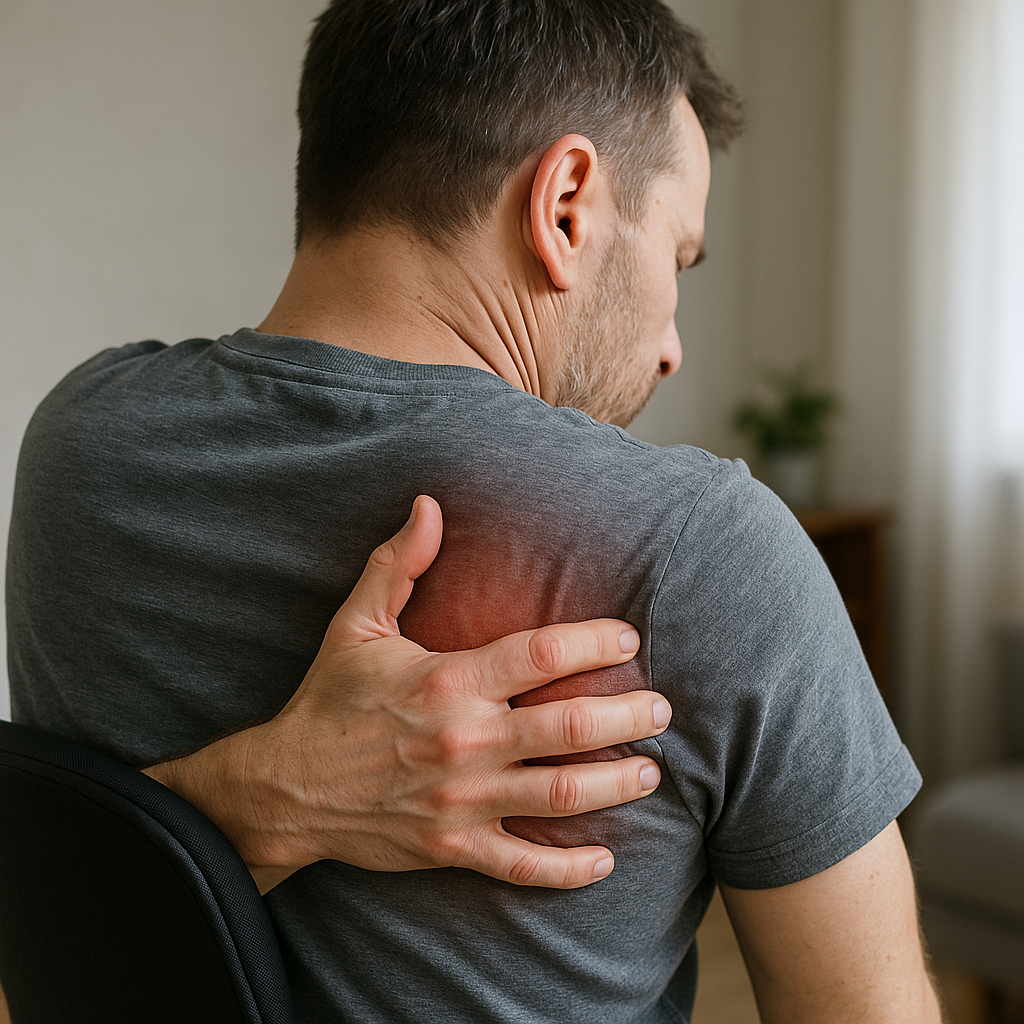Back pain is a common ailment that affects millions of people worldwide, with a significant number experiencing discomfort specifically in the side of the back. This type of pain can be particularly perplexing due to its varied origins, which can be either musculoskeletal or related to internal organs. Understanding the potential causes of pain in the side of the back is crucial for effective management and relief of symptoms.
common misconceptions about back pain
One of the most pervasive myths about back pain is that it is always caused by poor posture or muscle strain. While these are indeed common culprits, the reality is that back pain, especially when localized to one side, can arise from a multitude of sources. This includes issues such as kidney stones, infections, or even problems related to other internal organs like the pancreas or gallbladder. Recognizing this complexity is vital for accurate diagnosis and treatment.
Another misconception is that back pain is always a result of physical activity or injury. While activities like lifting, twisting, or sudden movements can certainly lead to muscle or ligament strains, it's important to consider other potential causes. For instance, conditions like arthritis or osteoporosis can contribute to back pain without any apparent external injury.
engaging with the mystery of side back pain
Have you ever experienced a mysterious pain on one side of your back and wondered what could be causing it? This type of pain can be both frustrating and concerning, especially when the cause is not immediately apparent. By exploring the hidden causes of pain in the side of the back, you can gain a better understanding of your symptoms and take proactive steps towards relief.
In the following sections, we will delve deeper into the specific musculoskeletal and internal causes of side back pain, providing you with a comprehensive guide to identifying and managing this common issue. Whether your pain is due to muscle strain, an internal organ issue, or another cause, understanding the root of the problem is the first step towards effective management and relief.
musculoskeletal causes of pain in the side of the back
Musculoskeletal issues are among the most common causes of pain in the side of the back. Understanding these can help in identifying the source of discomfort and determining the best course of action for relief.
muscle or ligament strain
Muscle or ligament strain is a frequent culprit behind side back pain. This condition often arises from overuse, improper lifting techniques, or sudden movements. Activities such as sports, manual labor, or even everyday tasks like lifting heavy grocery bags can result in these strains. When muscles or ligaments are overstretched or torn, they can cause significant discomfort, often described as a sharp or dull ache localized to one side of the back.

Lumbar support belt
Provides stabilisation and relief for lower back pain. Adjustable and ideal for daily use.
sprains and disc problems
While strains involve muscles and tendons, sprains affect the ligaments, which are the fibrous tissues connecting bones. Sprains are typically caused by sudden movements or trauma, leading to pain and swelling. Additionally, disc problems, such as bulging or herniated discs, can exert pressure on nearby nerves, resulting in radiating pain that often extends from the back to the legs. This nerve compression can lead to symptoms ranging from mild discomfort to severe, shooting pain.
internal organ issues contributing to back pain
Aside from musculoskeletal causes, pain in the side of the back can also stem from issues with internal organs. This type of pain is often referred to as visceral pain and can be more challenging to diagnose.
kidney problems
Kidney-related issues, such as stones or infections, frequently manifest as pain on one side of the back. This pain can range from a dull ache to severe, cramping discomfort. Accompanying symptoms often include changes in urinary habits, such as increased frequency or blood in the urine, and sometimes fever. Recognizing these symptoms early can be crucial for effective treatment and management.
other organ-related causes
Several other internal conditions may present as back pain. Pancreatitis, for example, can cause pain that radiates to the back, often accompanied by nausea and digestive issues. Gallstones and appendicitis are also known to cause referred pain to the back. In women, gynecological issues like endometriosis and pelvic inflammatory disease can similarly cause discomfort in the side of the back, highlighting the importance of considering a wide range of potential causes.
arthritis and osteoporosis as contributors to back pain
Chronic conditions like arthritis and osteoporosis can also lead to pain in the side of the back, particularly in older adults.
arthritis
Arthritis, including osteoarthritis and ankylosing spondylitis, involves inflammation of the joints, which can lead to chronic pain and stiffness in the back. This inflammation can limit mobility and significantly impact daily activities, underscoring the importance of early diagnosis and management.
osteoporosis and fractures
Osteoporosis, characterized by reduced bone density, increases the risk of fractures, particularly in the spine. These fractures can cause sudden, sharp pain in the side of the back and are more prevalent in older adults. Preventive measures, including calcium and vitamin D supplementation and weight-bearing exercises, can help mitigate these risks.
recognizing emergency signs
While many causes of side back pain are not life-threatening, certain symptoms warrant immediate medical attention. Sharp, severe pain, especially when accompanied by leg weakness, numbness, or incontinence, may indicate nerve compression or a spinal infection. These red-flag symptoms require prompt evaluation by a healthcare professional to prevent further complications.
Understanding the diverse causes of pain in the side of the back is essential for effective management. Whether the pain is due to musculoskeletal issues, internal organ problems, or chronic conditions, identifying the underlying cause is the first step towards relief and recovery. In the next section, we will explore prevention strategies and management options, empowering you to take control of your back health.
prevention and management of pain in the side of the back
Addressing pain in the side of the back involves a combination of preventive measures and effective management strategies. By making ergonomic and lifestyle adjustments, individuals can reduce the risk of developing back pain and manage existing discomfort more effectively.
ergonomic and lifestyle adjustments
Maintaining good posture is crucial in preventing back pain. Using ergonomic furniture, such as chairs with lumbar support, can significantly reduce strain on the back during prolonged sitting. Incorporating regular stretching exercises into your daily routine can also enhance flexibility and strength, reducing the likelihood of muscle or ligament strain.

Men's Posture Shirt™ - Black
Promotes better posture and can relieve pain or tension in back and shoulders.
For individuals engaged in manual labor or sports, proper lifting techniques are essential. This includes bending at the knees instead of the waist and avoiding twisting movements while lifting heavy objects. Ergonomic aids, such as back braces or supportive footwear, can provide additional support and help prevent injuries.
self-care and medical interventions
For those experiencing mild to moderate pain, self-care strategies can be effective. Resting the affected area, applying ice or heat, and using over-the-counter pain relief can alleviate symptoms. However, if pain persists or worsens, seeking professional evaluation is crucial. Healthcare providers may recommend physical therapy, chiropractic care, or other interventions based on the underlying cause of the pain.
symptom checklists for pain in the side of the back
Understanding the symptoms associated with different causes of side back pain can help individuals determine the urgency of their condition. Here is a brief overview of symptoms and potential causes:
- Muscle strain: Localized pain, often after physical activity or sudden movement.
- Kidney issues: Dull or severe pain, possibly with urinary changes or fever.
- Disc problems: Radiating pain, numbness, or tingling in the legs.
- Arthritis: Chronic pain and stiffness, often worsening with activity.
- Emergency signs: Sharp, severe pain with leg weakness, numbness, or incontinence.
Recognizing these symptoms can guide individuals in deciding whether to seek immediate medical attention or manage their condition with self-care.
conclusion
Understanding the diverse causes of pain in the side of the back is essential for effective management and relief. By adopting preventive measures, engaging in self-care, and knowing when to seek professional help, individuals can take proactive steps to alleviate discomfort and improve their overall back health. Empowering yourself with knowledge about the potential causes and symptoms is the first step towards a pain-free life.
frequently asked questions
What are the most common causes of pain in the side of the back?
The most common causes include muscle or ligament strain, kidney issues, and disc problems. These can result from physical activities, internal organ conditions, or degenerative changes in the spine.
When should I see a doctor for side back pain?
It is important to see a doctor if you experience severe pain, numbness, weakness in the legs, or incontinence. These symptoms may indicate a serious condition requiring immediate medical attention.
Can lifestyle changes help with side back pain?
Yes, lifestyle changes such as ergonomic adjustments, regular exercise, and proper lifting techniques can significantly reduce the risk of back pain and help manage existing symptoms.
How can I tell if my back pain is related to an internal organ?
Back pain related to internal organs often presents with additional symptoms such as urinary changes, digestive issues, or fever. If you suspect an internal cause, it is advisable to seek medical evaluation for accurate diagnosis and treatment.
Källor
- Mandaya Hospital Group. "Causes of Left Side Lower Back Pain."
- NCBI. "Low Back Pain."
- UnityPoint Health. "What Causes Back Pain and How to Find Relief."
- Harvard Health. "Back Pain."
- Florida Surgery Consultants. "Right Side Back Pain."
- MedlinePlus. "Back Pain."
- Mayo Clinic. "Back Pain: Symptoms and Causes."
- ADA. "Symptoms and Causes of Back Pain."
- UT Southwestern Medical Center. "5 Signs Your Back Pain Might Be an Emergency."
- Cleveland Clinic. "Back Pain."
- University of Maryland Medical System. "Spine Signs and Symptoms."


















